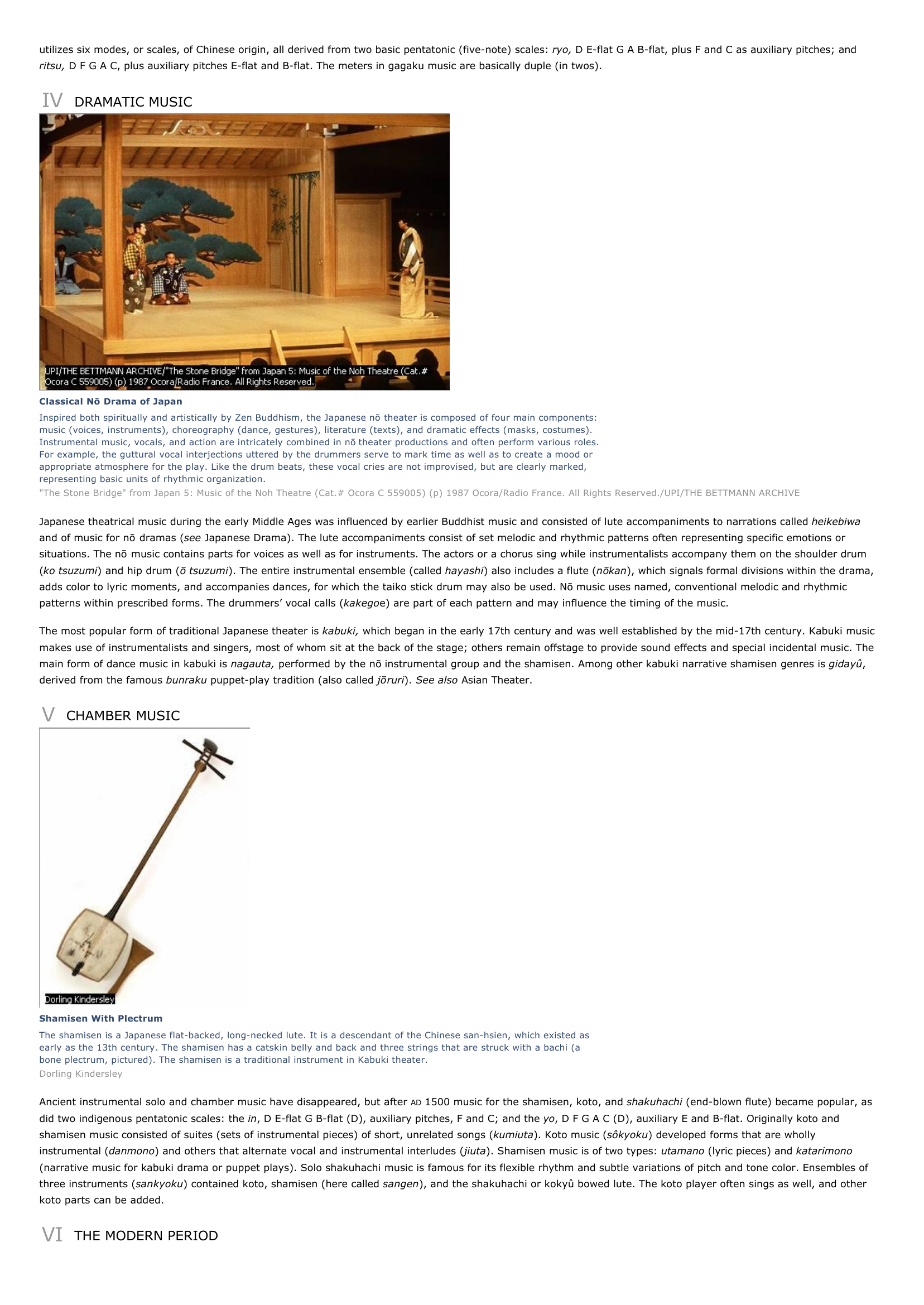Japanese Music I INTRODUCTION Shamisen Performance The shamisen is a Japanese instrument with three strings.
Publié le 12/05/2013

Extrait du document
«
utilizes six modes, or scales, of Chinese origin, all derived from two basic pentatonic (five-note) scales: ryo, D E-flat G A B-flat, plus F and C as auxiliary pitches; and ritsu, D F G A C, plus auxiliary pitches E-flat and B-flat.
The meters in gagaku music are basically duple (in twos).
IV DRAMATIC MUSIC
Classical Nō Drama of JapanInspired both spiritually and artistically by Zen Buddhism, the Japanese n ō theater is composed of four main components:music (voices, instruments), choreography (dance, gestures), literature (texts), and dramatic effects (masks, costumes).Instrumental music, vocals, and action are intricately combined in n ō theater productions and often perform various roles.For example, the guttural vocal interjections uttered by the drummers serve to mark time as well as to create a mood orappropriate atmosphere for the play.
Like the drum beats, these vocal cries are not improvised, but are clearly marked,representing basic units of rhythmic organization."The Stone Bridge" from Japan 5: Music of the Noh Theatre (Cat.# Ocora C 559005) (p) 1987 Ocora/Radio France.
All Rights Reserved./UPI/THE BETTMANN ARCHIVE
Japanese theatrical music during the early Middle Ages was influenced by earlier Buddhist music and consisted of lute accompaniments to narrations called heikebiwa and of music for n ō dramas ( see Japanese Drama).
The lute accompaniments consist of set melodic and rhythmic patterns often representing specific emotions or situations.
The n ō music contains parts for voices as well as for instruments.
The actors or a chorus sing while instrumentalists accompany them on the shoulder drum(ko tsuzumi ) and hip drum ( ō tsuzumi ).
The entire instrumental ensemble (called hayashi ) also includes a flute ( n ōkan ), which signals formal divisions within the drama, adds color to lyric moments, and accompanies dances, for which the taiko stick drum may also be used.
N ō music uses named, conventional melodic and rhythmicpatterns within prescribed forms.
The drummers’ vocal calls ( kakego e) are part of each pattern and may influence the timing of the music.
The most popular form of traditional Japanese theater is kabuki, which began in the early 17th century and was well established by the mid-17th century.
Kabuki music makes use of instrumentalists and singers, most of whom sit at the back of the stage; others remain offstage to provide sound effects and special incidental music.
Themain form of dance music in kabuki is nagauta, performed by the n ō instrumental group and the shamisen.
Among other kabuki narrative shamisen genres is gidayû , derived from the famous bunraku puppet-play tradition (also called jō ruri ).
See also Asian Theater.
V CHAMBER MUSIC
Shamisen With PlectrumThe shamisen is a Japanese flat-backed, long-necked lute.
It is a descendant of the Chinese san-hsien, which existed asearly as the 13th century.
The shamisen has a catskin belly and back and three strings that are struck with a bachi (abone plectrum, pictured).
The shamisen is a traditional instrument in Kabuki theater.Dorling Kindersley
Ancient instrumental solo and chamber music have disappeared, but after AD 1500 music for the shamisen, koto, and shakuhachi (end-blown flute) became popular, as did two indigenous pentatonic scales: the in, D E-flat G B-flat (D), auxiliary pitches, F and C; and the yo, D F G A C (D), auxiliary E and B-flat.
Originally koto and shamisen music consisted of suites (sets of instrumental pieces) of short, unrelated songs ( kumiuta ).
Koto music ( sôkyoku ) developed forms that are wholly instrumental ( danmono ) and others that alternate vocal and instrumental interludes ( jiuta).
Shamisen music is of two types: utamano (lyric pieces) and katarimono (narrative music for kabuki drama or puppet plays).
Solo shakuhachi music is famous for its flexible rhythm and subtle variations of pitch and tone color.
Ensembles ofthree instruments ( sankyoku ) contained koto, shamisen (here called sangen ), and the shakuhachi or kokyû bowed lute.
The koto player often sings as well, and other koto parts can be added.
VI THE MODERN PERIOD.
»
↓↓↓ APERÇU DU DOCUMENT ↓↓↓
Liens utiles
- African Music I INTRODUCTION Sacred Christian Music of Nigeria Among the Igede people of Nigeria, Christianity has been syncretized with the existing religious belief system.
- Rock Music I INTRODUCTION Carlos Santana Mexican-born guitarist Carlos Santana became a superstar in the late 1960s with a string of hits and an appearance at the famous Woodstock rock festival in 1969.
- Electronic Music I INTRODUCTION Electronic Music, music that requires the use of electronic devices to produce or manipulate sound during its composition and performance.
- Ballet I INTRODUCTION Tchaikovsky's The Nutcracker The Nutcracker is a classic ballet with music by Peter Ilyich Tchaikovsky.
- Eunomia (Order) Greek A goddess of order and lawful conduct and one of the three Horae, guardians of the seasons, with her sisters Dike (Justice) and Eirene (Peace).












